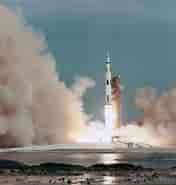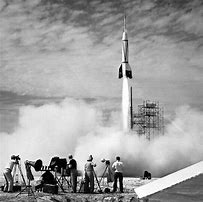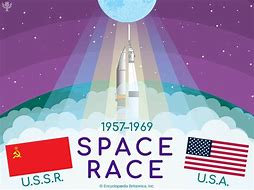The Space Race, which spanned most of the Cold War era, stands as one of the most intense periods of global competition. This was not just a technological rivalry, but a contest for global dominance. The United States and the Soviet Union were the main players. Both sought to prove their power, technological capabilities, and the superiority of their political systems. This race to space led to some groundbreaking achievements, shaping the future of space exploration and global competition. This article delves into the origins, major events, and lasting impact of the Space Race.

Introduction: The Dawn of the Space Age
The Space Race started in the mid-20th century. It was a time when humanity was on the brink of space exploration. The race wasn’t just about space; it was also about power and pride. The United States and the Soviet Union were caught up in Cold War tensions. Both countries wanted to show that they could reach beyond Earth. The race would prove who had the upper hand in this new, exciting frontier. Early successes and failures in space exploration were seen as a reflection of each country’s power on the global stage.
For those watching, the Space Race was a thrilling journey. Could we really break free from Earth’s gravity? Would one country outpace the other in reaching space? The early days were marked by both hope and fear. These milestones would forever shape space exploration. They also highlighted the fierce competition between these two superpowers.
The Birth of the Space Race
The Cold War and the Emergence of Space as a Battleground
The Space Race emerged alongside the Cold War, the global conflict between the capitalist United States and the communist Soviet Union. By the 1940s and 1950s, both sides were competing for global influence. As tensions mounted, space became a new front in their battle. A successful space program would be proof of technological superiority. It wasn’t just about rockets and satellites; it was a symbol of political and military strength. Each side saw space exploration as vital to proving their dominance.
The First Shot Fired: Sputnik 1
On October 4, 1957, the Soviet Union took the first significant step. They launched Sputnik 1, the world’s first artificial satellite. The launch sent shockwaves around the world. In the United States, it was seen as a blow to national pride. Sputnik 1 orbited Earth, showing that the Soviets had the technology to reach space. This event sparked the Space Race. It pushed the United States to rapidly develop its own space program.
The U.S. felt the pressure. The launch of Sputnik made the U.S. realize that it had to catch up. This event triggered the United States to push forward with a renewed urgency to develop space technologies.

The United States Responds
The Formation of NASA
In response to Sputnik, the United States moved quickly. On July 29, 1958, President Dwight D. Eisenhower created NASA. The National Aeronautics and Space Administration was formed to lead America’s space efforts. NASA’s mission was clear: catch up to the Soviets and eventually surpass them. The goal wasn’t just to launch satellites but to prove that democracy and capitalism could drive space exploration.
Project Mercury and Alan Shepard
The first major manned spaceflight program in the U.S. was Project Mercury. Launched in 1958, its goal was to send an American astronaut into space. On May 5, 1961, Alan Shepard became the first American to travel into space. However, his flight was suborbital, not yet a full orbit around Earth. While it was a significant achievement, it was just the beginning. The U.S. was determined to go further, aiming to do even more before the Soviets.
The Key Milestones: The Race Heats Up
The Soviet Union Strikes Back: Yuri Gagarin
The Soviet Union didn’t rest on its laurels. On April 12, 1961, the Soviets launched Vostok 1, sending Yuri Gagarin into space. Gagarin became the first human to orbit Earth. His flight was a huge victory for the Soviet Union. The Soviets had once again demonstrated their space capabilities, and the world watched. This success put more pressure on the United States to step up its game.
Gagarin’s flight was a huge success for the Soviet Union. The achievement made the world realize the Soviets were ahead in the race. The United States now had to work even harder to catch up.
Kennedy’s Bold Declaration: Landing on the Moon
On May 25, 1961, President John F. Kennedy set a bold goal for the U.S. He announced that America would land a man on the Moon before the decade was over. His statement was both ambitious and challenging. It wasn’t just about reaching space anymore—it was about landing on the Moon. This goal became a rallying point for the nation. Kennedy’s vision was to prove that the U.S. could accomplish what seemed impossible.

The Apollo Program and the Moon Landing
The Apollo Missions: Reaching for the Stars
NASA worked tirelessly from 1961 to 1969. The goal was to safely land astronauts on the lunar surface and bring them back. The Apollo missions were monumental, facing many obstacles. But NASA pressed forward, determined to meet Kennedy’s challenge. By 1969, they were ready for their most significant mission yet.
Apollo 11: The Historic Moon Landing
On July 20, 1969, Apollo 11 achieved what many thought was impossible. Astronauts Neil Armstrong and Buzz Aldrin became the first humans to walk on the Moon. Armstrong’s famous words, “That’s one small step for [a] man, one giant leap for mankind,” echoed across the world. The United States had won the ultimate victory in the Race. The Moon landing was not only a technological feat but also a political triumph. It solidified America’s position as the leader in space exploration.
The Apollo 11 mission was a defining moment in history. It marked the culmination of years of effort and competition. The U.S. had reached the Moon while the Soviet Union had been left behind.
The End of the Space Race and Its Lasting Impact
The Final Years of the Space Race
The Space Race continued for a few more years. The U.S. and the Soviet Union worked on their space programs. However, by 1975, the Apollo-Soyuz Test Project took place. This was the first time U.S. and Soviet spacecraft docked in space. This cooperative mission marked the end of the Space Race. Both countries now turned to collaboration in space rather than competition.
Read This: Royal Regalia: A Timeless Tapestry of Power and Elegance
The Impact on Global Geopolitics
The Race had profound political consequences. For the Soviet Union, space achievements were meant to showcase the superiority of communism. However, despite early successes, the U.S. ultimately won the race to the Moon. This victory gave the U.S. a significant boost in global prestige and influence. Space exploration also led to technological advancements that benefitted society, such as satellite communications and medical technologies.
The Legacy of the Space Race
The legacy of the Space Race is still felt today. The race led to the development of new technologies that continue to benefit us. NASA’s successes paved the way for future missions, including those to the Moon and Mars. The Space Race also helped foster international cooperation in space. Future missions like the International Space Station (ISS) were built on the groundwork laid during the Cold War rivalry.
The Role of the Space Race in Shaping Modern Space Exploration
Collaboration Over Competition
After the Space Race ended, cooperation in space became more common. The U.S. and Russia, once fierce rivals, began to work together on various space missions. Today, international collaboration is a hallmark of space exploration. The ISS is a prime example of how former enemies can now unite for peaceful exploration.
The New Space Race: Private Industry
While government space agencies led the Space Race, today private companies are playing a central role. Companies like SpaceX and Blue Origin are now leading efforts to reach Mars, the Moon, and beyond. This new race is not just between countries but also private corporations. Competition is now global in a new, exciting way.
Conclusion: The Space Race’s Enduring Legacy
The Space Race was more than just a rivalry between the U.S. and the Soviet Union. It was a global event that captured the imagination of people around the world. The race led to major technological advancements, such as the Moon landing, satellite communications, and space exploration technologies. The rivalry pushed both nations to achieve incredible feats. Today, the legacy of the Space Race continues to inspire the world’s efforts in space exploration. The lessons learned during this time shape the direction of modern space missions and innovations. The spirit of exploration, competition, and collaboration remains an enduring force in humanity’s quest to explore the stars.
FAQs
1. What was the Space Race?
The Space Race was a competition between the U.S. and the Soviet Union to achieve milestones in space exploration, including launching satellites and landing a man on the Moon.
2. Why was the Space Race important?
The Space Race was important because it was a symbol of political and technological superiority. The country that succeeded in space was seen as more advanced.
3. How did the Space Race impact space exploration?
The Space Race led to the rapid development of space technology and set the stage for future missions, including lunar landings, satellite technologies, and deep space exploration.
4. Who won the Space Race?
The United States ultimately won the Space Race by landing a man on the Moon with Apollo 11 in 1969, although the Soviet Union achieved many early milestones.
5. What is the legacy of the Space Race?
The Space Race’s legacy includes technological innovations, international collaboration in space, and the continued pursuit of space exploration today. It sparked interest in space sciences and has led to many modern advancements.


